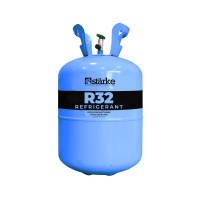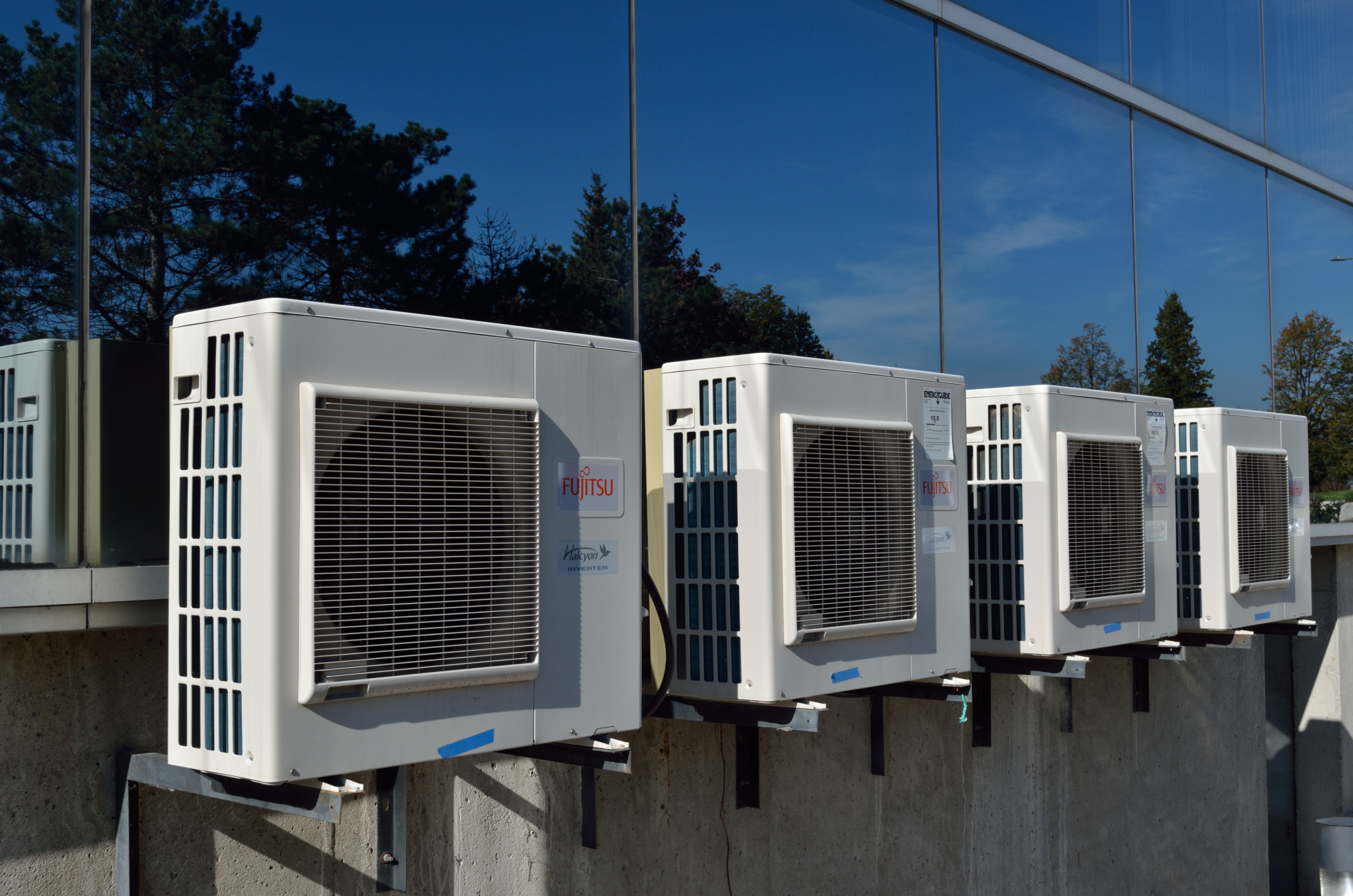|
R-410A
R-410A is a refrigerant fluid used in air conditioning and heat pump applications. It is a zeotropic but near- azeotropic mixture of difluoromethane (CH2F2, called R-32) and pentafluoroethane (CHF2CF3, called R-125). R-410A is sold under the trademarked names AZ-20, EcoFluor R410, Forane 410A, Genetron R410A, Puron, and Suva 410A. On December 27, 2020, the United States Congress passed the American Innovation and Manufacturing (AIM) Act, which directs US Environmental Protection Agency (EPA) to phase down production and consumption of hydrofluorocarbons (HFCs). The AIM act was passed because HFCs have high global warming potential. Rules developed under the AIM Act require HFC production and consumption to be reduced by 85% from 2022 to 2036. R-410A will be restricted by this Act because it contains the HFC R-125. Other refrigerants with lower global warming potential will replace R-410A in most applications, just as R-410A replaced the earlier ozone-depleting refrigerant, R-22. ... [...More Info...] [...Related Items...] OR: [Wikipedia] [Google] [Baidu] |
Refrigerant
A refrigerant is a working fluid used in the cooling, heating, or reverse cooling/heating cycles of air conditioning systems and heat pumps, where they undergo a repeated phase transition from a liquid to a gas and back again. Refrigerants are heavily regulated because of their toxicity and flammability, as well as the contribution of CFC and HCFC refrigerants to ozone depletion and the contribution of HFC refrigerants to climate change. Refrigerants are used in a direct expansion (DX) circulating system to transfer energy from one environment to another, typically from inside a building to outside or vice versa. These can be air conditioner cooling only systems, cooling & heating reverse DX systems, or heat pump and heating only DX cycles. Refrigerants are controlled substances that are classified by several international safety regulations and, depending on their classification, may only be handled by qualified engineers due to extreme pressure, temperature, flammability, ... [...More Info...] [...Related Items...] OR: [Wikipedia] [Google] [Baidu] |
Heat Pump
A heat pump is a device that uses electricity to transfer heat from a colder place to a warmer place. Specifically, the heat pump transfers thermal energy using a heat pump and refrigeration cycle, cooling the cool space and warming the warm space. In winter a heat pump can move heat from the cool outdoors to warm a house; the pump may also be designed to move heat from the house to the warmer outdoors in summer. As they transfer heat rather than generating heat, they are more energy-efficient than heating by gas boiler. A gaseous refrigerant is compressed so its pressure and temperature rise. When operating as a heater in cold weather, the warmed gas flows to a heat exchanger in the indoor space where some of its thermal energy is transferred to that indoor space, causing the gas to condense into a liquid. The liquified refrigerant flows to a heat exchanger in the outdoor space where the pressure falls, the liquid evaporates and the temperature of the gas falls. It is no ... [...More Info...] [...Related Items...] OR: [Wikipedia] [Google] [Baidu] |
R-454B
R-454B, also known by the trademarked names Opteon XL41, Solstice 454B, and Puron Advance, is a zeotropic blend of 68.9 percent difluoromethane (R-32), a hydrofluorocarbon, and 31.1 percent 2,3,3,3-tetrafluoropropene (R-1234yf), a hydrofluoroolefin. Because of its reduced global warming potential (GWP), R-454B is intended to be an alternative to refrigerant R-410A in new equipment. R-454B has a GWP of 466, which is 78 percent lower than R-410A's GWP of 2088. R-454B is non-toxic and mildly flammable, with an ASHRAE safety classification of A2L. In the United States, it is expected to be packaged in a container that is red or has a red band on the shoulder or top. There is a shortage of R-454B in the United States as of May 2025. History The refrigeration industry has been seeking replacements for R-410A because of its high global warming potential. R-454B, formerly known as DL-5A, has been selected by several manufacturers. R-454B was developed at and is manufactured by Chemours. ... [...More Info...] [...Related Items...] OR: [Wikipedia] [Google] [Baidu] |
Difluoromethane
Difluoromethane, also called HFC-32 is an organofluorine compound with the formula CH2F2. It is a colorless gas that is used as a refrigerant. Synthesis Difluoromethane is produced by the reaction of dichloromethane and hydrogen fluoride (HF) using SbF5 as a catalyst. : Applications Difluoromethane is used as refrigerant that has prominent heat transfer and pressure drop performance, both in condensation and vaporization. Difluoromethane is currently used by itself in residential and commercial air-conditioners in Japan, China, and India as a substitute for R-410A. In order to reduce the residual risk associated with its mild flammability, this molecule should be applied in heat transfer equipment with low refrigerant charge such as brazed plate heat exchangers (BPHE), or shell and tube heat exchangers and tube and plate heat exchangers with tube of small diameter. Many applications confirmed that difluoromethane exhibits heat transfer coefficients higher than those ... [...More Info...] [...Related Items...] OR: [Wikipedia] [Google] [Baidu] |
Air Conditioning
Air conditioning, often abbreviated as A/C (US) or air con (UK), is the process of removing heat from an enclosed space to achieve a more comfortable interior temperature, and in some cases, also controlling the humidity of internal air. Air conditioning can be achieved using a mechanical 'air conditioner' or through other methods, such as passive cooling and ventilative cooling. Air conditioning is a member of a family of systems and techniques that provide Heating, ventilation, and air conditioning, heating, ventilation, and air conditioning (HVAC). Heat pumps are similar in many ways to air conditioners but use a reversing valve, allowing them to both heat and cool an enclosed space. Air conditioners, which typically use vapor-compression refrigeration, range in size from small units used in vehicles or single rooms to massive units that can cool large buildings. Air source heat pumps, which can be used for heating as well as cooling, are becoming increasingly common in cool ... [...More Info...] [...Related Items...] OR: [Wikipedia] [Google] [Baidu] |
HCFC And HFC Atmospheric Trends
Chlorofluorocarbons (CFCs) and hydrochlorofluorocarbons (HCFCs) are fully or partly halogenated hydrocarbons that contain carbon (C), hydrogen (H), chlorine (Cl), and fluorine (F). They are produced as volatile derivatives of methane, ethane, and propane. The most common example of a CFC is dichlorodifluoromethane (R-12). R-12, also commonly called Freon, is used as a refrigerant. Many CFCs have been widely used as refrigerants, propellants (in aerosol applications), gaseous fire suppression systems, and solvents. As a result of CFCs contributing to ozone depletion in the upper atmosphere, the manufacture of such compounds has been phased out under the Montreal Protocol, and they are being replaced with other products such as hydrofluorocarbons (HFCs) and hydrofluoroolefins (HFOs) including R-410A, R-134a and R-1234yf. Structure, properties and production As in simpler alkanes, carbons in CFCs bond with tetrahedral symmetry. Because the fluorine and chlorine atoms differ gr ... [...More Info...] [...Related Items...] OR: [Wikipedia] [Google] [Baidu] |
Chlorodifluoromethane
Chlorodifluoromethane or difluoromonochloromethane is a hydrochlorofluorocarbon (HCFC). This colorless gas is better known as HCFC-22, or R-22, or . It was commonly used as a propellant and refrigerant. These applications were phased out under the Montreal Protocol in Developed country, developed countries in 2020 due to the compound's ozone depletion potential (ODP) and high global warming potential (GWP), and in developing countries this process will be completed by 2030. R-22 is a versatile intermediate in industrial organofluorine chemistry, e.g. as a precursor to tetrafluoroethylene. Production and current applications Worldwide production of R-22 in 2008 was about 800Gg per year, up from about 450Gg per year in 1998, with most production in developing countries. R-22 use is being phased out in developing countries, where it is largely used for air conditioning applications. R-22 is prepared from chloroform: :HCCl3 + 2 HF → HCF2Cl + 2 HCl An important application ... [...More Info...] [...Related Items...] OR: [Wikipedia] [Google] [Baidu] |
Pentafluoroethane
Pentafluoroethane is a fluorocarbon with the formula CF3CHF2. Pentafluoroethane is currently used as a refrigerant (known as R-125) and also used as a fire suppression agent in fire suppression systems. Pentafluoroethane does not deplete ozone so it has replaced earlier fluorinated chemicals that did. However while it has zero ozone depletion potential, it has high global warming potential, reported by the United States Environmental Protection Agency (EPA) as 3450 times that of carbon dioxide. Refrigerant Pentafluoroethane in a near azeotropic mixture with difluoromethane is known as R-410A, a common replacement for various chlorofluorocarbons (commonly known as ''Freon'') in new refrigerant systems. Fire suppression systems HFC-125 (ECARO-25 / FE-25 / NAF S 125) is a gaseous fire suppression agent which can be used in clean agent fire suppression systems. In addition, HFC-125 leaves no residue on valuable equipment and material after discharge. It is generally used in situatio ... [...More Info...] [...Related Items...] OR: [Wikipedia] [Google] [Baidu] |
Global Warming Potential
Global warming potential (GWP) is a measure of how much heat a greenhouse gas traps in the atmosphere over a specific time period, relative to carbon dioxide (). It is expressed as a multiple of warming caused by the same mass of carbon dioxide (). Therefore, by definition has a GWP of 1. For other gases it depends on how strongly the gas absorbs thermal radiation, how quickly the gas leaves the atmosphere, and the time frame considered. For example, Methane emissions, methane has a GWP over 20 years (GWP-20) of 81.2. meaning that, a Fugitive gas emissions, leak of a tonne of methane is equivalent to emitting 81.2 tonnes of carbon dioxide measured over 20 years. As methane has a much shorter atmospheric lifetime than carbon dioxide, its GWP is much less over longer time periods, with a GWP-100 of 27.9 and a GWP-500 of 7.95. The carbon dioxide equivalent (e or eq or -e or -eq) can be calculated from the GWP. For any gas, it is the mass of that would warm the earth as much as the ... [...More Info...] [...Related Items...] OR: [Wikipedia] [Google] [Baidu] |
Ozone Depletion
Ozone depletion consists of two related events observed since the late 1970s: a lowered total amount of ozone in Earth, Earth's upper atmosphere, and a much larger springtime decrease in stratospheric ozone (the ozone layer) around Earth's polar regions. The latter phenomenon is referred to as the #Ozone hole and its causes, ozone hole. There are also springtime polar tropospheric ozone depletion events in addition to these stratospheric events. The main causes of ozone depletion and the ozone hole are manufactured chemicals, especially manufactured halocarbon refrigerants, solvents, propellants, and foam-blowing agents (chlorofluorocarbons (CFCs), HCFCs, Haloalkanes, halons), referred to as ''ozone-depleting substances'' (ODS). These compounds are transported into the stratosphere by Turbulence, turbulent mixing after being emitted from the surface, mixing much faster than the molecules can settle. Once in the stratosphere, they release atoms from the halogen group through photod ... [...More Info...] [...Related Items...] OR: [Wikipedia] [Google] [Baidu] |
Flash Point
The flash point of a material is the "lowest liquid temperature at which, under certain standardized conditions, a liquid gives off vapours in a quantity such as to be capable of forming an ignitable vapour/air mixture". The flash point is sometimes confused with the autoignition temperature, the temperature that causes spontaneous ignition. The fire point is the lowest temperature at which the vapors keep burning after the ignition source is removed. It is higher than the flash point, because at the flash point vapor may not be produced fast enough to sustain combustion. Neither flash point nor fire point depends directly on the ignition source temperature, but ignition source temperature is far higher than either the flash or fire point, and can increase the temperature of fuel above the usual ambient temperature to facilitate ignition. Fuels The flash point is a descriptive characteristic that is used to distinguish between flammable fuels, such as petrol (also known as g ... [...More Info...] [...Related Items...] OR: [Wikipedia] [Google] [Baidu] |









